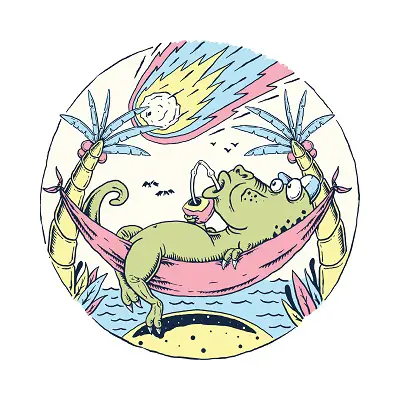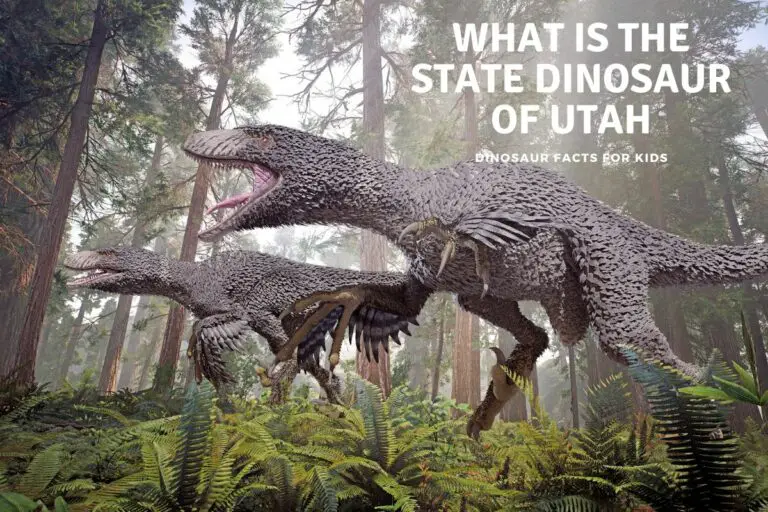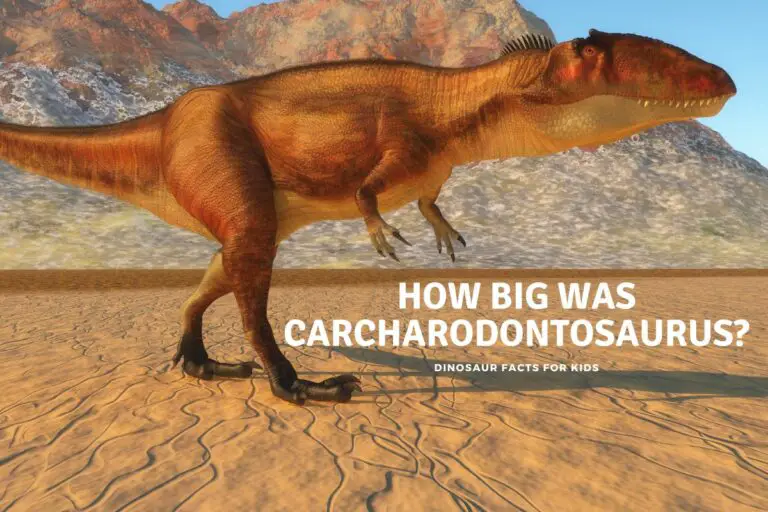Are Crocodiles Related To Dinosaurs?
The horrifying thrill of Jurassic Park seems missing in real life until you watch a crocodile take down a living animal. Scaly skin, reptile eyes and huge jaws, the reason crocodiles seem so eerily similar to certain dinosaurs is because the two are actually biologically close. Dinosaurs have fascinated our imagination and curiosity ever since their remains were discovered and it looks like the closest things we have living today are crocodiles. So, are crocodiles related to dinosaurs?
Crocodiles and Dinosaurs are related as they descend from the same common ancestor, the Archosaur. However they evolved into different species million of years ago. Humans and chimpanzees are related in the same way as crocodiles and dinosaurs, and this relation is known as sibling species.
In this article, you will learn more about how crocodiles and dinosaurs are related their similar traits and differences, and why one species survived and adapted while the other could not. More importantly, you will learn whether crocodiles were around when dinosaurs walked the Earth. So, let’s get started!
Are Crocodiles Dinosaurs?
Although related in the distant past through a common ancestor crocodiles and dinosaurs are not the same and not descended from each other. In fact they come from an animal called an Archosaur ( more on that in the next section) There were more animals alive millions of years ago than solely the dinosaurs. Although dinosaurs certainly get most of the attention!
Other animals alive at the same time also came from the same descendant (archosaur) these include pterosaurs, (flying reptiles) plesiosaurs ( water dinosaurs) and mosasaurs

What was the first crocodile?
Crocodiles have been around for a very long time indeed, They have evolved, even though they still look very similar to how they did a long time ago. Their nostrils have moved, early crocodiles had more armour and their teeth were serrated, which crocodile teeth today are not.
One of the first crocodilians was is thought to be the Phytosaurs who lived even before most dinosaurs were even born during the Triassic period 240 million years ago! they looked similar as we mentioned but were more suited to aquatic life rather than terrestrial ( land) based. They had shorter mouths, and were smaller in general than their later relatives.
Phytosaur actually means plant lizard, but those sharp teeth show that it was a carnivore. however early crocodiles, although mostly meat eating, did have some members of their family that would have eaten plants, and been omnivores as well.
Are Crocodiles related to Dinosaurs?
Crocodiles did not descend from dinosaurs, but both evolved from Archosaurs. Which means Crocodiles related to dinosaurs is now accepted. There were multiple Archosaurs types in the Triassic period (246 to 229 million years ago). The socket-toothed Archosaur eventually evolved into the dinosaur, while the Erpetosuchus (long Archosaur) became crocodiles.
In other words, had the dinosaurs survived their apocalypse, they would not have evolved into crocodiles over the few hundred million years. That’s because their respective ancestor, Archosaurs, were quite different already and had taken a different evolutionary direction.
The Archosaurs that evolved into dinosaurs had already started putting more weight on their hind legs. The crocodile ancestors were getting closer and closer to the ground with each evolutionary leap.

Were Crocodiles Around During the Dinosaur Era?
Now that you know that both dinosaurs and crocodiles evolved from two types of archosaurs that descended from the single Archosaur, you might think about the pace of their evolution. How long did these changes take to happen.
When the dinosaurs took their distinct forms, what form were the Erpetosuchus (crocodile ancestor archosaur) descendants?
Crocodiles were around during the dinosaur era (Jurassic and Cretaceous Periods) in a pretty similar shape (but different size) to what they look like today. The Deinosuchus was a descendent of Erpetosuchus in the last age of dinosaurs and looked like a giant version of the modern crocodiles. We take a look below at some crocodile relatives in the table below.
What Crocodiles lived at the same time as dinsaours.
We have researched 5 of the more famous prehistoric crocodiles that lived at the same time as the dinosaurs and put the information in the table below. There were actually many over the 200 million years or so the dinosaurs were alive.
Table 1: Crocodiles and dinosaurs living together.
| Dinosaur Crocodilian | Name meaning | When they lived | How Big | Diet |
| Deinosuchus | Terrible Crocodile | Late Cretaceous 82-75 million Years ago | up to 39 feet long | Fish, Marine reptiles and Dinosaurs |
| Rhamphosuchus | Beak Crocodile | Miocene 25 – 5 million years ago | 26-36 feet long | Fish and Land Animals |
| Sarcosuchus | Flesh Crocodile | Cretaceous 133 – 112 million years ago | up to 31 feet | Fish and dinosaurs |
| Confractosuchus* | Broken dinosaur crocodile. | Late Cretaceous 95 million years ago | 8 feet – probably bigger. ( its newly discovered) | Dinosaurs (definitely!) Fish |
| Postosuchus | Crocodile from the post. | Triassic 221 -203 Million years ago | 13-16 feet long | early dinosaurs and large herbivores |
*Confractosauches was found with the remains of a small dinosaur (an ornithopod) in its stomach. It was though that although the crocodile was only 8 feet long it could have grown much bigger. it is exciting to find evidence of how dinosaurs ate and very rare
The dinosaur bones inside the crocodile were of a young dinosaur and probably a new species as well! So they found two new species in one fossil! it was found in Australia in 2010 and named in 2022. it is a very new species of prehistoric crocodile.
What was the Biggest Dinosaur Crocodile?
Currently the largest crocodilian of all time is thought to be the Deinosuchus. With the largest found measuring over 10.6 metres (35 feet) long. It is thought that it may have grown to over 12 meters (39 feet) when full grown. It lived 82-75 million years ago during the late cretaceous period and had a diet fo fish and land based dinosaurs
It was certainly large enough weighing up to 18,000 lbs to take down a large dinosaurs that stayed too long by the waters edge. It looked very much like the crocodiles of today, expect for the huge size of course, and it thought to have lived in a similar environment and a similar sedentary (slow) lifestyle)
Fossils have been found all across what is now the USA from Montana to Texas and it may have adapted its hunting style depending where it lived. It names means terrible crocodile and it is easy to see why!
Although it is widely considered the largest crocodilian species ever other large dinosaur crocodiles may have been similar or even largeR in size like Rhamphosuchus, and Sarcosuchus

Why Haven’t Crocodiles Evolved?
Given that tens of millions of years have passed since the last visibly different form of crocodiles crawled the waters, it is reasonable to wonder why this species doesn’t seem to have evolved a lot.
Crocodiles have evolved but not a lot compared to other species across the same timespan. They achieved a stable body plan over a hundred million years ago. Being apex predators in an environment that changed very little, they did not need to change to survive.
Evolution does not occur as a deliberately designed transformation. Instead, random mutations arise until a specific one gives an organism a slight edge over the others. Mutations, aside from size reduction, didn’t benefit crocodiles’ survival because their bodies are ideal for their hunting strategy.
Smaller crocodiles could better surprise their prey and would require less food to survive. Consequently, they had a better chance of living long enough to reproduce. That’s what resulted in the modern crocodiles being the mini-versions of the crocodiles around the last dinosaurs. Though the largest known crocodile in the modern era is the Saltwater Crocodile which has been measured at 20ft long. Not sure that could be called a “mini-version”

How Did Crocodiles Survive the Asteroid?
If crocodiles were around when dinosaurs existed, they were around when the asteroid caused the mass extinction of dinosaurs. So how did they survive such a catastrophic event and its after effects.
Crocodiles survived the asteroid and its consequences because they’re biologically equipped to withstand drastic environmental changes that killed off most of their sibling species. Crocodiles can survive in water and can live in complete darkness.
Here are some of the consequences of the dinosaur-killing asteroid:
- Shockwaves – Winds of up to 621 miles per hour went in all directions from the point of impact. Crocodiles were not large enough to be directly hit by the shockwave, and could have shelters in water.
- Debris rain – The pieces of the asteroid and the solids that became airborne from the crater rained down on the Earth. Crocodiles live near water and could have taken shelter in the deep blue.
- Wildfires – One consequence of the impact was a series of wildfires, which some crocodiles could avoid because they could take shelter in water.
- Toxic atmosphere – The air became toxic because of the airborne vapor after the asteroid impact. Again, crocodiles could survive in water and swim away from land.
- Temperature changes – The global temperature changed drastically after the impact, but Crocodiles’ bodies can handle a wide range of temperatures, which helped them survive.
- Sea life was less impacted by the impact after effects than land animals, so food sources would have been better in water and for water based predators.
- Less nutricion needed. Crocodiles were cold blooded and reptiles need less food than warm, or even half warm blooded animals. Handy when 70% of land animals were wiped out!
Differences Between Dinosaurs and Crocodiles
Every biological advantage that crocodiles had that helped them survive the Chicxulub crater’s consequences was missing from the dinosaurs. Here are some ways in which dinosaurs and crocodiles are different.
| Crocodiles | Dinosaurs |
| Are alive | Are extinct |
| Have legs that branch toward their sides | Almost always had their legs directly underneath them |
| Are currently carnivorous | Some dinosaurs used to be herbivores |
| Are cold-blooded | Were mesotherms |
| They are always parallel to the ground | Rising vertical stature, with only a few dinosaurs having a horizontal default position |
| Can live in water and on land | All dinosaurs except the Spinosaurus lived on the land-only |
Similarities Between Crocodiles and Dinosaurs
Having established how these sibling species are different, we can now look at some ways their common biology showed through in the form of common traits. Here are some ways crocodiles and dinosaurs are related.
- Rubbery skin covered in scales
- Large jaws, and teeth and claws
- Clearly reptilian appearance
With that in mind, let’s go over the common ancestor of the dinosaurs and the crocodiles. The Archosaur was more similar to the crocodile than the dinosaurs, which shows the evolutionary preference toward the flatter, water-friendly form.
We have a few in a series of articles about other animals that may or may not be related to dinosaurs on the site, some are listed below. Feel free to take a look.
- Are Chickens dinosaurs?
- Are Alligators dinosaurs
- Are Sharks related to dinosaurs
- Are Turtles related to dinosaurs
- Are Lizards related to dinosaurs
- Is a rhinoceros a Dinosaur?
Conclusion: Crocodiles and Dinosaurs are Related?
Crocodiles and Dinosaurs were related as closely as humans and chimpanzees. The modern-day crocodiles share a common ancestor with the dinosaurs, and they look pretty similar to this ancestor.
In the same way that when you look at birds, you can see the similarities to dinosaurs, theropods dinosaurs today.
Having traits like the ability to survive in water and cold-blooded circulation helped them survive the incident that rendered the dinosaurs extinct. Since then, the crocodiles have endured over a hundred million years without evolving except for getting smaller and some nostril movement.
They were an almost perfect hunter 200 million years ago, and remain an almost prefect hunter to this day.
References
https://a-z-animals.com/blog/are-alligators-dinosaurs/
https://www.cbc.ca/kidscbc2/the-feed/5-animals-with-prehistoric-ancestors
https://a-z-animals.com/blog/are-crocodiles-dinosaurs/
https://www.nationalgeographic.com/science/article/crocodiles-are-not-living-fossils
Hi, I am Roy Ford a General Studies and English Teacher who has taught all over the world. What started as a fossil collection became a great way to teach, motivate and inspire students of all ages and all over the world about dinosaurs and from that and children’s love of dinosaurs came the site dinosaur facts for kids, a resource for all ages.







